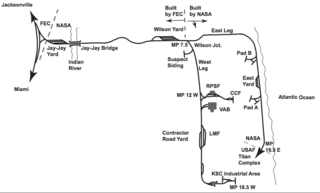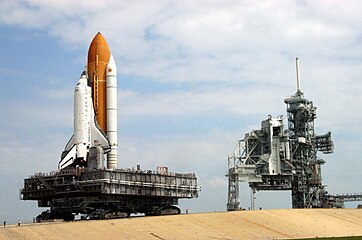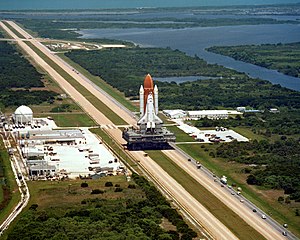
The John F. Kennedy Space Center, located on Merritt Island, Florida, is one of the National Aeronautics and Space Administration's (NASA) ten field centers. Since December 1968, KSC has been NASA's primary launch center of American spaceflight, research, and technology. Launch operations for the Apollo, Skylab and Space Shuttle programs were carried out from Kennedy Space Center Launch Complex 39 and managed by KSC. Located on the east coast of Florida, KSC is adjacent to Cape Canaveral Space Force Station (CCSFS). The management of the two entities work very closely together, share resources and operate facilities on each other's property.

The Space Shuttle program was the fourth human spaceflight program carried out by the U.S. National Aeronautics and Space Administration (NASA), which accomplished routine transportation for Earth-to-orbit crew and cargo from 1981 to 2011. Its official name, Space Transportation System (STS), was taken from a 1969 plan for a system of reusable spacecraft of which it was the only item funded for development. It flew 135 missions and carried 355 astronauts from 16 countries, many on multiple trips.

The Vehicle Assembly Building, or VAB, is a large building at NASA's Kennedy Space Center (KSC), designed to assemble large pre-manufactured space vehicle components, such as the massive Saturn V, the Space Shuttle and the Space Launch System, and stack them vertically onto one of three mobile launcher platforms used by NASA. As of March 2022, the first Space Launch System (SLS) rocket was assembled inside in preparation for the Artemis 1 mission, launched on November 16, 2022.

The Constellation program was a crewed spaceflight program developed by NASA, the space agency of the United States, from 2005 to 2009. The major goals of the program were "completion of the International Space Station" and a "return to the Moon no later than 2020" with a crewed flight to the planet Mars as the ultimate goal. The program's logo reflected the three stages of the program: the Earth (ISS), the Moon, and finally Mars—while the Mars goal also found expression in the name given to the program's booster rockets: Ares. The technological aims of the program included the regaining of significant astronaut experience beyond low Earth orbit and the development of technologies necessary to enable sustained human presence on other planetary bodies.

Launch Complex 39A (LC-39A) is the first of Launch Complex 39's three launch pads, located at NASA's Kennedy Space Center in Merritt Island, Florida. The pad, along with Launch Complex 39B, was first designed to accommodate the Saturn V launch vehicle. Typically used to launch NASA's crewed spaceflight missions since the late 1960s, the pad was leased by SpaceX and has been modified to support their launch vehicles.

A service structure is a steel framework or tower that is built on a rocket launch pad to facilitate assembly and servicing.

Launch Complex 39 (LC-39) is a rocket launch site at the John F. Kennedy Space Center on Merritt Island in Florida, United States. The site and its collection of facilities were originally built as the Apollo program's "Moonport" and later modified for the Space Shuttle program.

A mobile launcher platform (MLP), also known as mobile launch platform, is a structure used to support a large multistage space vehicle which is assembled (stacked) vertically in an integration facility and then transported by a crawler-transporter (CT) to a launch pad. This becomes the support structure for launch.

The Exploration Systems Architecture Study (ESAS) is the official title of a large-scale, system level study released by the National Aeronautics and Space Administration (NASA) in November 2005 of his goal of returning astronauts to the Moon and eventually Mars—known as the Vision for Space Exploration. The Constellation Program was cancelled in 2010 by the Obama Administration and replaced with the Space Launch System, later renamed as the Artemis Program in 2017 under the Trump Administration.

The Crawlerway is a 130-foot-wide (40 m) double pathway at the Kennedy Space Center in Florida. It runs between the Vehicle Assembly Building and the two launch pads at Launch Complex 39. It has a length of 3.4 and 4.2 miles to Pad 39A and Pad 39B, respectively. A seven-foot (2 m) bed of stones lies beneath a layer of asphalt and a surface made of Alabama river rocks.

The astronaut transfer van, known as the Astrovan during the Space Shuttle era, was a NASA vehicle used at the Kennedy Space Center to transport astronauts from the Operations and Checkout Building to the launch pad before a mission and for launch dress rehearsals, and back to the Operations and Checkout Building following a shuttle landing.

The Mid-Atlantic Regional Spaceport (MARS) is a commercial space launch facility located at the southern tip of NASA's Wallops Flight Facility on Wallops Island in Virginia, just east of the Delmarva Peninsula and south of Chincoteague, Virginia, United States. It is owned and operated by the Virginia Spaceport Authority.

Launch Complex 39B (LC-39B) is the second of Launch Complex 39's three launch pads, located at NASA's Kennedy Space Center in Merritt Island, Florida. The pad, along with Launch Complex 39A, was first designed for the Saturn V launch vehicle, which at the time was the United States' most powerful rocket. Typically used to launch NASA's crewed spaceflight missions since the late 1960s, the pad is currently configured for use by the agency's Space Launch System rocket, a Shuttle-derived launch vehicle which is currently used in the Artemis program and subsequent Moon to Mars campaigns. The pad had also been leased by NASA to aerospace company Northrop Grumman, for use as a launch site for their Shuttle-derived OmegA launch vehicle, for National Security Space Launch flights and commercial launches, before the OmegA program was cancelled.

Ares I-X was the first-stage prototype and design concept demonstrator of Ares I, a launch system for human spaceflight developed by the National Aeronautics and Space Administration (NASA). Ares I-X was successfully launched on October 28, 2009. The project cost was $445 million. It was the final launch from LC-39B until Artemis 1 13 years later.

The NASA Railroad is a Class III industrial short-line railroad at the Kennedy Space Center in Cape Canaveral, Florida. The railroad consists of 38 miles (61 km) of track connecting the mainline of the Florida East Coast Railway and trackage at the Cape Canaveral Space Force Station. NASA uses the railroad to deliver large or bulk materials to support its operations, particularly solid rocket boosters and chemicals such as helium and oxygen for rocket fuel.

The retirement of NASA's Space Shuttle fleet took place from March to July 2011. Discovery was the first of the three active Space Shuttles to be retired, completing its final mission on March 9, 2011; Endeavour did so on June 1. The final shuttle mission was completed with the landing of Atlantis on July 21, 2011, closing the 30-year Space Shuttle program.

Artemis 1, officially Artemis I and formerly Exploration Mission-1 (EM-1), was an uncrewed Moon-orbiting mission. As the first major spaceflight of NASA's Artemis program, Artemis 1 marked the agency's return to lunar exploration after the conclusion of the Apollo program five decades earlier. It was the first integrated flight test of the Orion spacecraft and Space Launch System (SLS) rocket, and its main objective was to test the Orion spacecraft, especially its heat shield, in preparation for subsequent Artemis missions. These missions seek to reestablish a human presence on the Moon and demonstrate technologies and business approaches needed for future scientific studies, including exploration of Mars.

OmegA was a medium-lift to heavy-lift launch vehicle concept that spent several years in development by Northrop Grumman during 2016–2020, with that development substantially funded by the U.S. government. OmegA was intended for launching U.S. national security satellites, as part of the U.S. Department of the Air Force National Security Space Launch (NSSL) replacement program.

NASA's Exploration Ground Systems (EGS) Program is one of three programs based at NASA's Kennedy Space Center in Florida. EGS was established to develop and operate the systems and facilities necessary to process and launch rockets and spacecraft during assembly, transport and launch. EGS is preparing the infrastructure to support NASA's Space Launch System (SLS) rocket and its payloads, such as the Orion spacecraft for Artemis I. Artemis I is the first to launch in a series of increasingly complex missions that will enable human exploration to the Moon and Mars.
































